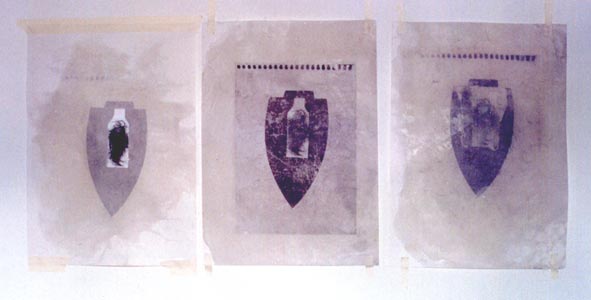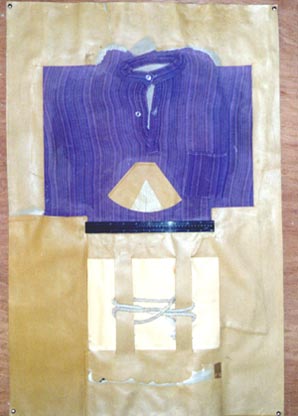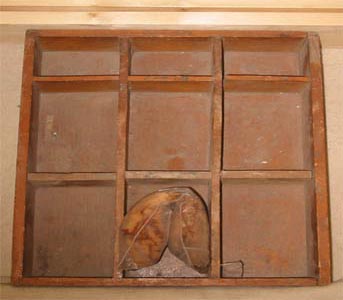| Visual Arts | China | ||||||||||||||||||||||||||||||||||||||||||||||
BAFA © 2010. All material here is copyrighted. See conditions above. |
Martin Derbyshire / Ma Teng Fei |
 Martin Derbyshire, 2004 Photo: Sonja van Kerkhoff |
|
|
 Process, mixed media, 2001, 50 x 30 cm. |
I believe that the greatest challenge facing us at the beginning of the third millennium is to transcend the fragmentation that informs contemporary thought and acknowledge the originating and unifying factors that underlie its multi-faceted appearance.
Interview with Wendy van Overmeeren, The Netherlands / China.
|
 Resonance, mixed media, 2001, 100 x 50 cm. WvM: Are you not afraid that people will associate it with something gross, like hair you find in the shower? MD: They might do, but hair is just hair. Who decided it was gross? Our associations reveal as much about our own mindset as what we're looking at. When it is on the head of someone you love, it becomes very special. The Bahá´í archives contain locks of hair from the Central Figures of the Faith. Keeping a loved one's lock of hair is an old tradition common to many cultures. People may associate hair with something gross, but that does not bother me. Part of what I am doing is provoking people's sense of beauty and acceptability. I want to challenge conventional definitions of beauty and, because I question the authority and motivations of their exponents. They are exclusive and commodified by market interests. When Baha'u'llah and Abdu'l-Baha describe humanity as being the flowers of one garden, they seem to be saying that beauty and perfection are intrinsic to the relationships that evolve between different created elements. The realization of individual elements' innate qualities is conditional upon their interaction with others'. When you encounter an organic material that comes from the body, next to a manufactured inflexible one, both their individual and universal properties are made more apparent by the shared context they are presented in.
|
 Voice, mixed media, 1999-2001, 120 x 80 cm.
| In one of my works, I have enclosed a lock of hair within the interior of an iron- a theme which is further explored in a series of works on paper in which the iron assumes a protective, womb, heart-or locket like presence. Such configurations are seldom contrived; rather they are arrived at during the intuitive process of resolving a piece.
|
Even though the actual iron is absent, traces of it and its use are found in many pieces, leading the mind to re-affirm its presence by recalling the general concept of "iron". In this way, the iron-print functions as a device to induce a process of remembrance and abstraction: thus serving as a bridge between material and intellectual reality.
|
I don't consciously sit down and think: Okay, I'm going to make a piece about this… Rather, the work is a personal reflection on our search for meaning, which I believe, is understood when we interact with it. If you take an object and say: Okay, I know what this is- but then discover it in a different- even cultural- context- your certainty is shaken. It becomes something else.
|
 Recipent, mixed media, 1999-2001, 120 x 80 cm. |
|
WvM: When did you come to China and what brought you here?
MD: I came to China in 1995 because for a long time I was interested in Chinese philosophy and Buddhism and through it became interested in Chinese art. In Los Angeles, I had the chance to meet visiting scholars and students and through them I became more interested in China and decided to come over. I did not want to come as a tourist and be given a sanitized version. I really wanted to understand the country. So I came for a year as a teacher and have been here ever since. At the moment, I'm employed as a lecturer by a UK university, that is developing joint art and design programmes with Chinese academies, where many Chinese artists work after they have graduated from university. I feel that within Chinese society, besides a fundamental respect for art and artists, there is a growing receptivity to new art and ideas, which is transforming the arts scene and creating a lot more opportunities for artists to produce and exhibit new kinds of work. I had a show in Shanghai in 1999 and am working on another one in Beijing.
A Chinese teacher gave me the name, Ma Teng Fei. It means Galloping Horse. It's an atypical Chinese name, but it carries an association with the west of China, where I first lived. I alternate between the two names (English and Chinese) and tend to use it to deflect attention from myself (i.e. foreign artist) towards the work. Anonymity or uncertainty about the identity of its author is something I'm interested in because it delays the satisfaction people feel when they've got you in a bag.
WvM: When did you start?
MD: When I was a kid. I began my degree at art school when I was sixteen in 1988, and graduated from the Fine Art department of the University of Central Lancashire in 1992. I have been producing art ever since. My work used to be very gestural, with lots of expressions of character: much more calligraphic. But now it is concepts of space and emptiness that I am interested in.
There are several environments in my life that have strongly influenced my work and my relationship with materials and objects. Besides China, the Bahá´í World Centre in Haifa, and especially the Archives building has been very inspirational. The objects there have a power and carry a resonance that is incredibly moving.
Another is Auschwitz. Totally opposite when we think of what they represent, but there are connections that go beyond the superficial museum context. The objects there are poignant embodiments of tragedy and suffering. In Haifa, things are placed with great reverence, whilst in Auschwitz things appeared to have been casually thrown into the corner of a room or abandoned, suggesting violence and desperation. After both these experiences, an object was never just an object again. It became an element of consciousness, with the power to influence and convey meaning.
The protagonists whose dramatic lives defined not only each environment, but also the different concepts of humanity they embody are no longer physically present; but the common everyday objects associated with them cannot be separated from the knowledge we have of their existence. The objects become the channels through which we are drawn closer to their experience and to a heightened awareness of self. If this is true of all three environments, in which the unremarkable becomes transformed through the associations it creates, then it must be so for every area of the undivided reality to which they belong. This concept is central to my work: that the physical world is both a metaphor through which we engage with the process of being and the projection of our attempts to interpret and understand it.
View more work on this web site: http://www.newchineseart.com/artists/matengfei.htm
There are several environments in my life that have strongly influenced my work and my relationship with materials and objects. Besides China, the Bahá´í World Centre in Haifa, and especially the Archives building has been very inspirational. The objects there have a power and carry a resonance that is incredibly moving.
Another is Auschwitz. Totally opposite when we think of what they represent, but there are connections that go beyond the superficial museum context. The objects there are poignant embodiments of tragedy and suffering. In Haifa, things are placed with great reverence, whilst in Auschwitz things appeared to have been casually thrown into the corner of a room or abandoned, suggesting violence and desperation. After both these experiences, an object was never just an object again. It became an element of consciousness, with the power to influence and convey meaning.
The protagonists whose dramatic lives defined not only each environment, but also the different concepts of humanity they embody are no longer physically present; but the common everyday objects associated with them cannot be separated from the knowledge we have of their existence. The objects become the channels through which we are drawn closer to their experience and to a heightened awareness of self. If this is true of all three environments, in which the unremarkable becomes transformed through the associations it creates, then it must be so for every area of the undivided reality to which they belong. This concept is central to my work: that the physical world is both a metaphor through which we engage with the process of being and the projection of our attempts to interpret and understand it.
View more work on this web site: http://www.newchineseart.com/artists/matengfei.htm
|
Arts Dialogue, Dintel 20, NL 7333 MC, Apeldoorn, The Netherlands email: bafa@bahai-library.com |
 It has also become fashionable to work with technology. Some Chinese artists have gone digital. That's fine, I totally embrace it as a viable medium for artists. But some believe that the medium itself makes for interesting art. In fact it doesn't- it's what you say with it. Technology at the moment is really still the property of the few. I think a person with limited means has just as much chance of reflecting profound truth as a person who lives in a state of material prosperity. It is the depth of reflection one brings to one's interactions, rather than an abundance of information that leads to true understanding. I try to express a spirit of working with what you have and what is around you by reflecting the insights you can potentially gain from your immediate environment.
It has also become fashionable to work with technology. Some Chinese artists have gone digital. That's fine, I totally embrace it as a viable medium for artists. But some believe that the medium itself makes for interesting art. In fact it doesn't- it's what you say with it. Technology at the moment is really still the property of the few. I think a person with limited means has just as much chance of reflecting profound truth as a person who lives in a state of material prosperity. It is the depth of reflection one brings to one's interactions, rather than an abundance of information that leads to true understanding. I try to express a spirit of working with what you have and what is around you by reflecting the insights you can potentially gain from your immediate environment.